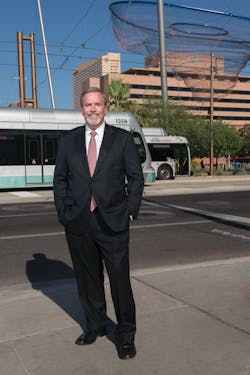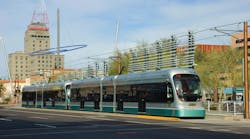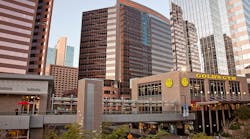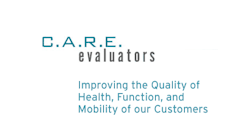From an electrician in the Navy to CEO of Valley Metro in Phoenix, Ariz., Stephen Banta has had a wide range of experiences. After getting out of the Navy in 1986, he went to work at San Diego Trolley as an electrician fixing rail cars. He and his wife later wanted to head back East to be closer to family and after applying and testing, got a job at Washington Metropolitan Area Transit Authority in D.C. “The story just leap frogs from there,” Banta said.
He worked at the Los Angeles County Metropolitan Transportation Authority, Dallas Area Rapid Transit, the Port Authority of Allegheny County and in 2007 to TriMet as the executive director as part of a 4-year contract. He was on month 30 when the opportunity presented itself at Valley Metro as the CEO and he’s been in the position since January, 2010.
“Working from the shop floor to a position of management allows me a little bit of credibility with the operating ranks on the front line to be able to engage with them to put them maybe a little more at ease in conversation,” he said. “I recognize the terminology they use and where they’ve been and it allows also an opportunity to bring that focus to the executive conference room with the executive team as we make decisions each and every day.”
He added, “I can remember a time when I worked on the shop floor saying, ‘Boy, if I was the GM or if I was the CEO, it sure wouldn’t be run like this.” He laughed, “Well now I am and that haunts me.”
Growing as a Region
Valley Metro has been growing into a regional system. When Banta first came to the Valley there were four service providers: the Regional Public Transportation Authority, Valley Metro Rail and then there was the city of Tempe and the city of Phoenix.
In 2012, Banta took the role of CEO of the RPTA and Valley Metro Rail and reports to both boards.
RPTA adopted the name Valley Metro in 1993 and the local governments fund the Valley-wide system. In 2002, the not-for-profit Valley Metro Rail Inc. formed to design, construct and operate the light rail system which first opened in December, 2008. As of July 2013, Valley Metro will start providing the service for the city of Tempe, so the four service providers are down to two: Valley Metro and the city of Phoenix.
With the regionalization comes being able to better integrate services. Banta pointed to a transit map that is a significant indication of where they’ve come. When he first came to the Valley, the system map was really demarked by city boundaries but now, has eliminated those boundaries. “We’re calling it transit without borders,” he said. “We’re able to look at that map now and clearly see from a transit perspective how you can get from one point of the Valley to the other.”
It’s also been a fiscally sustainable thing to do. Banta said, “We’re actually saving money in salaries and wages. We were able with a combination of the two systems to eliminate duplicity; we’re looking at roughly about $1.4 million in reduced salaries and we’re also in a growth mode.
“We were able to take some of the additional savings and put them toward growth positions to offset some of the external costs of added positions.”
Valley Metro Operations Director Jim Wright talked about the combining of the two operations: the Mesa and Tempe operations. “We’ve spent the last year merging it,” he said.
When they moved into the Mesa facility they had about 49 vehicles. The shop was built for 100 and today, they have about 177 fixed-route vehicles there. At the Tempe facility, the shop was built for 250 vehicles and they have about 112 vehicles. “Part of unifying the properties is that we can now right-size the properties without making any more capital investment,” Wright explained.
Due to separate contracts and that each operation did things a little different, they weren’t really able to achieve some of the efficiencies that they needed to be more cost-effective. “This process gives us the opportunity to, what I could call right-size — not only the physical infrastructure but also the efficiency of it.”
“We know it’s economically more efficient because the market has told us what the answer is,” Wright said. CH2M Hill’s Cynthia Pollen led a team and staff at each operation to bring everyone together to weigh in and come together with a product that everyone could feel comfortable with.
When it comes to agency integration, Banta stated that the first lesson is you have to message the integration the right way. “It’s not that the region has been doing it wrong for a long time but there are other ways in which to deliver a little bit better service, maybe more efficiently and less administrative cost,” he said.
Hot Valley Service
While I was visiting Valley Metro back in early May, the weatherman on the morning news announced it was “only going to get up to 100°” for the day. Operating in the desert has its share of challenges for a transit agency.
In the last five years Valley Metro has purchased more than 200 New Flyer buses for the Mesa and Tempe properties. Valley Metro Operations Director Jim Wright talked about some of the things that have been done to increase comfort for the passenger in their extreme environment.
While the standard for vehicle comfort was that manufacturers would look for a 20° temperature differential between ambient and inside the coach, in the desert that would bring the temperature down to 90 when it’s 100 out.
“Last summer we were with both New Flyer and Thermo King to come up with an additional condenser unit to give the air conditioning a little more capacity because we needed a little more surface area. The standard one just doesn’t quite work for this area,” Wright said.
A strain on the engine will start to shut things off and the first thing it shuts off — because it’s the biggest load — is the air conditioning system. He said two years ago they sent a vehicle up to Minneapolis to Thermo King for testing and brought it back here last July for final testing.
Thermo King’s Steve Johnson, product manager, transit and coach bus HVAC, said a high-capacity HVAC system needs to be capable of reducing interior temperatures from 100F to 72F in 30 minutes while the vehicle is idling. “Achieving this goal demands system components large enough to handle this load, specifically the compressor and the condense coil. The system also will need a high performance refrigerant with a robust compressor design.”
When looking over some of their newer vehicles, he also pointed out two other sustainable features. The interiors are now all LED lighting because they’re cooler and last the life of the vehicle. The other feature is that the seats are made from recycled water bottles. LaFrance Industries Sales Executive Joseph Brinkmeyer explained there are 150 water bottles recycled for use in one yard of fabric and approximately ¾ yard of fabric is used in each Valley Metro seat.
Transit Partners
Valley Metro has looked at various contract opportunities and Banta said with his previous experiences, all that he ever contracted out was paratransit service. “Coming here and looking at the different business model of contracted service makes you think differently about how you engage with that operator or maintenance group.” He said, “You cannot blur the lines of the contract requirements, but you’re engaging in providing that ownership piece that you really want in delivering that service. We’re still working on that to be quite honest.”
What they’ve done with the paratransit services — the East Valley dial-a-ride service — is the business model of brokering out the service. Banta said he was initially skeptical because it was seen as a last resort to contract with a local cab company. “I always struggled in the previous authorities to ensure that the driver showed up and the operator that showed up had the customer services sensitivities needed for that type of client.”
Wright explained that they were looking at $35 a boarding with their paratransit service, relying on the typical cutaway bus dispatched out of the Mesa facility. Providing about 220,000 passenger trips, he says they were looking at about $10 million a year.
The contract was awarded to a local cab company, Total Transit and that company also has a fixed-route contract for Valley Metro on the West side for some express service. The paratransit service was implemented last July and now the cost per boarding is about $23.
Banta said with the research in it that Wright had done and with Total Transit with Ron Barnes, he had the added measures to ensure that the taxi operators were going to be put through the proper training program. He said, “It’s worked very, very well.
Communications Manager Susan Tierney said it was difficult with that whole element of change in that a lot of dial-a-ride drivers had developed a relationship with the clients and they had been driving a long time. While some of the drivers were transitioned over to light rail if they wanted to apply to be a light rail operator, some retired and others went to work for a subcontractor that provides the brokered service.
During the transition process, Wright explained they met regularly for months during the startup and the marketing folks had a huge communications plan. “We had to, because it was such a cultural change.”
With Valley Metro’s new mobility center, they are now able to personally engage with the clients, allow them travel training opportunities and speak with them about opportunities to use fixed-route service which can provide more flexibility in their daily lives. In some cases, clients are certified on a trip-by-trip basis.
The customer service department needed to be moved as there wasn’t room in the new offices downtown and at the same time they were looking to build an assessment center. Valley Metro Customer Service Manager Scott Wisner said they happened to find a location, got a really great deal on the tenant improvement allowance and were then able to build out an ideal 11-square-foot facility two years ago.
The certification process used to be done through a paper process relying on clients to fill out forms and doctors to return forms within the 21-day window. Oftentimes they wouldn’t get forms back and would have to give presumptive eligibility.
The previous mindset, Wisner explained, was they didn’t want to make someone 100 percent eligible if they weren’t 100 percent sure, so they would give conditional eligibility. However, they weren’t enforcing it, so customers often got all the trips they wanted. With the new in-person eligibility assessment in place they’re seeing more customers fully eligible because they have the opportunity to see the person.
Today customers call the call center to inquire; they learn the process and get sent an application. After filling it out, they call for an appointment and that call goes to the contractor, C.A.R.E. Evaluators, which operates the in-person assessment out of the mobility center. After the assessment, C.A.R.E. Evaluators sends a report and a recommendation and Valley Metro staff makes the final quality assurance check and sends out the letter to the customer. “We’ve got it down now that the process is really quite efficient,” Wisner said.
For more information on the in-person evaluation process, the mobility center facility and the travel training program , visit www.MassTransitmag.com/10964269.
Of the partnerships with their other contracted services, Banta said it’s very different from some of his previous experience because instead of a direct relationship with the unions, they have a Veolia or a First Transit operating some of their service and they’re the ones that negotiate the labor agreements. Ultimately, he said, they’re partners with all of them — the labor force and the contract operator — to ensure they get the best opportunity for the rider.
Banta said, “Not being at the table presents some challenges because as a previous chief labor negotiator for labor contracts, I’d rather be at the table than hearing about what happened in another room and asking for support or other advice.” He added with a smile, “I’m learning to be patient.”
Community Partners
The contractors they work with aren’t the only partners talked about. The U.S. Airways Center is right downtown in Phoenix near a light rail station and the venue is home to the Phoenix Suns, Phoenix Mercury, Arizona Rattlers and a variety of other concerts and events. Senior Vice President General Manager Ralph Marchetta and Director of Ticket Operations Daren Mitch talked about the arrangement between the center and Valley Metro. Mitch said, “Anyone who has a ticket to an arena event can utilize the light rail system for free with their ticket.”
Marchetta explained that when the NBA All-Stars was coming to the venue in 2009 there were a lot of meetings planning for the event and that’s where the idea originated. “We worked with the idea of basically reimbursing Valley Metro based on what our drop count is and by drop count I mean actual attendance.” He said, “We came up with a number that I think everybody was comfortable with.
“The popularity of the program has been amazing. People love it.” He added “Why some of our colleagues don’t do some kind of the same program, I don’t get.”
Not only has there been a great response from their customers, Marchetta said it’s been a huge benefit to their program when marketing the venue. He said, “When we’re talking to artists, when we’re talking to Jimmy Buffet or a background band, I’m always pushing about this. We’re in a super competitive market so there are tons of options out there so I talk about centrally located, downtown Phoenix and this light rail program. That’s a huge benefit.”
To read details about the arrangement, visit www.MassTransitmag.com/1096423.
Light Rail in the Valley
When it comes to light rail, one of the biggest challenges they have in the Valley is that they can’t build it fast enough. There are two projects currently under construction in north-central Phoenix and in Mesa. “We’ve got plans to even extend further on both ends of the line,” Banta said.
Valley Metro Assistant Superintendent John Philippi explained Kinkisharyo had a 2-year build contract and then a 2-year maintenance contract. After that time, Valley Metro Rail took over. He and a number of the other employees out of the Metro Operations and Maintenance Center had previously been employed by Kinkisharyo. Currently the maintenance is done in-house and as of 2006, operations is contracted out to Alternate Concepts Inc. (ACI).
Underway is a 2-mile extension through Mesa and city of Mesa Mayor Scott Smith said he sees the option of light rail creates a lot of economic opportunities. The city even repurposed federal highway monies to do the extension.
“I think it was in President Reagan’s years that they allowed trade-offs,” he said. “We had a lot more in street funds than we had allocated for the cost of the 2-mile extension.” Due to changes in development patterns, there was an overpass that was no longer needed and he said they saw it as a waste of money. “We got widespread support, people understood the approach and we were able to do that.”
They faced the typical opposition prior to light rail: it’ll never be successful, we don’t have the density, it’s not our lifestyle. Smith stressed in every great metro area, you need transportation options. And, the city is already growing due to the light rail coming.
“We have four liberal arts colleges from around the country that are setting up campuses in downtown Mesa,” he said. “Every single one of them said without light rail, we’re not coming to downtown Mesa.” He also mentioned the Barry & Peggy Goldwater Library and Archives is going to be built in downtown Mesa and the reasons were that there were four colleges coming in and there was light rail coming in. Smith also said the last private investment in resident stock had been an apartment complex built almost 30 years ago and that in the last 10 months, there are four projects going in that are in excess of $50 million, purely because of light rail. “These are things that would not have happened.”
To read more from Mayor Smith about how they were able to fund this extension, visit www.MassTransitmag.com/10965028.
Opening earlier this year was the Phoenix Sky Harbor International Airport Sky Train, a 24/7 connection from terminal four at the airport to Valley Metro’s 44th Street/Washington light rail station. Though not a part of Valley Metro, they have an agreement with the city of Phoenix to market the service.
Jim Spakauskas, director of sales and business development with Bombardier Transportation Systems Divisions explained their role of designing, manufacturing, supplying and installing the fully automated driverless vehicles. There was a total of 18 vehicles delivered with the system and Spakauskas said they also signed a 10-year operations and maintenance contract with the city.
The vehicles are the Innovia APM 200 series vehicles controlled by their automatic train control technology Cityflo 650, a moving block technology. The train control technology is one they have already integrated with the Innovia APM vehicle and it is already operating at the Dallas/Fort Worth International Airport and London Heathrow Airport.
City of Phoenix Mayor Greg Stanton said the region is blessed to have an airport that’s located in the heart of the Valley and so they were looking to make it as convenient as possible. “To give our transit riders an opportunity to get to the airport without having to use a vehicle, to make it as convenient as possible for people and to get as many vehicles off the main campus as possible,” he stated.
This first phase to terminal four, the busiest terminal, was $644 million and the next phase, connecting to terminal three, will be $240 million. The funding was put together through airport revenues and passenger fees: no local tax dollars.
The Mayor Council serves as the board for the airport so they had to approve it. Stanton said, “Look, I’m the mayor so I believe in infrastructure investment.” He continued, “The more you can support and build upon your infrastructure, it’s great for the future of the city. It sends the right messages to people that may be thinking about doing business in your city that you’re willing to make tough decisions.
“You’ve got to have the strength of mind to get it done even during tough economic times.”
Growth and Management
Banta said there are five corridors at various stages of study and a challenge, Banta said, is managing all of those projects in a way that coincides with the cash flows from the regional tax and also to be able to provide the due diligence on each one with current staff and to not grow exponentially to an unsustainable level.
Regarding maintaining the system Banta said they have to have partners in the private sector with the cities and developers that invest in and develop around the infrastructure to provide some of that revenue back to the system. “As our system ages, we want to make sure that we maintain that system.” He continued, “We bring their customers, their clients and their employees to and from their front door.”
As part of the total transit network, Banta said an important component is the economic development opportunity it provides. There has been about $6 billion worth of investment around a little over a $1 billion transit system. “Right now we get $6 for one and the national average is $4.” He said, “So we’re doing a little bit better than the national average and folks don’t recognize that value.”
One person that does recognize the value of the light rail in downtown is Jeff Moloznik, vice president development with Red Development, the commercial real estate company behind CityScape, a 1.2-million-square-foot urban project in the core of downtown Phoenix. It’s located at a light rail stop and the mixed-use development features office, retail, apartments and a hotel.
He said the light rail line was one of the drivers for why this primarily retail development company chose this particular project for this location. “If the city, state and county are going to invest that kind of capital and the public is going to invest that kind of capital into a system like this long term, this site would have unlimited potential, regardless of what economic situation we were presented with.”
He said he has a philosophy on light rail that he always describes it to people as a natural resource, somewhat like a river. Rivers were used for transportation historically and around the river is where cities developed. “It’s not this revolutionary concept,” he stated. “We plan real estate around transportation infrastructure.”
CityScape has a 97 percent occupancy rate and while that’s important, Moloznik said the success rate is determined on the per square foot retail sales. And this project has some of the highest per square foot retail sales in the state.
To read more details of the project visit www.MassTransitmag.com/10964818.
Future Planning
Proposition 400 is the half-cent sales tax that was passed in 2004 that helps fund projects in the Regional Transportation Plan. The revenues are probably about $2 billion less than originally forecasted, Banta said, which is why they have had to prioritize some of the capital improvement projects and expansion plans.
The tax provides for operating and capital on the bus side and only capital on the rail side as there’s a firewall to not allow that money to be used for operation. Rail operations are paid for by the member cities in which it operates through an equation based on track mileage. He also said that there are some cities in the Valley that have a local transit tax outside the regional countywide tax and there is some money they get from the lottery.
Banta said with the Prop 400 and other local money, they have a lot more dedicated funding then some of the other transit authorities. He said, “It’s a great story for me when I go back to Washington and the FTA … I’m not always there back with my hand out. We’re telling them about the things we’re doing in the region without support from Washington or the DOT.
“It’s important to be able to send that message.”







